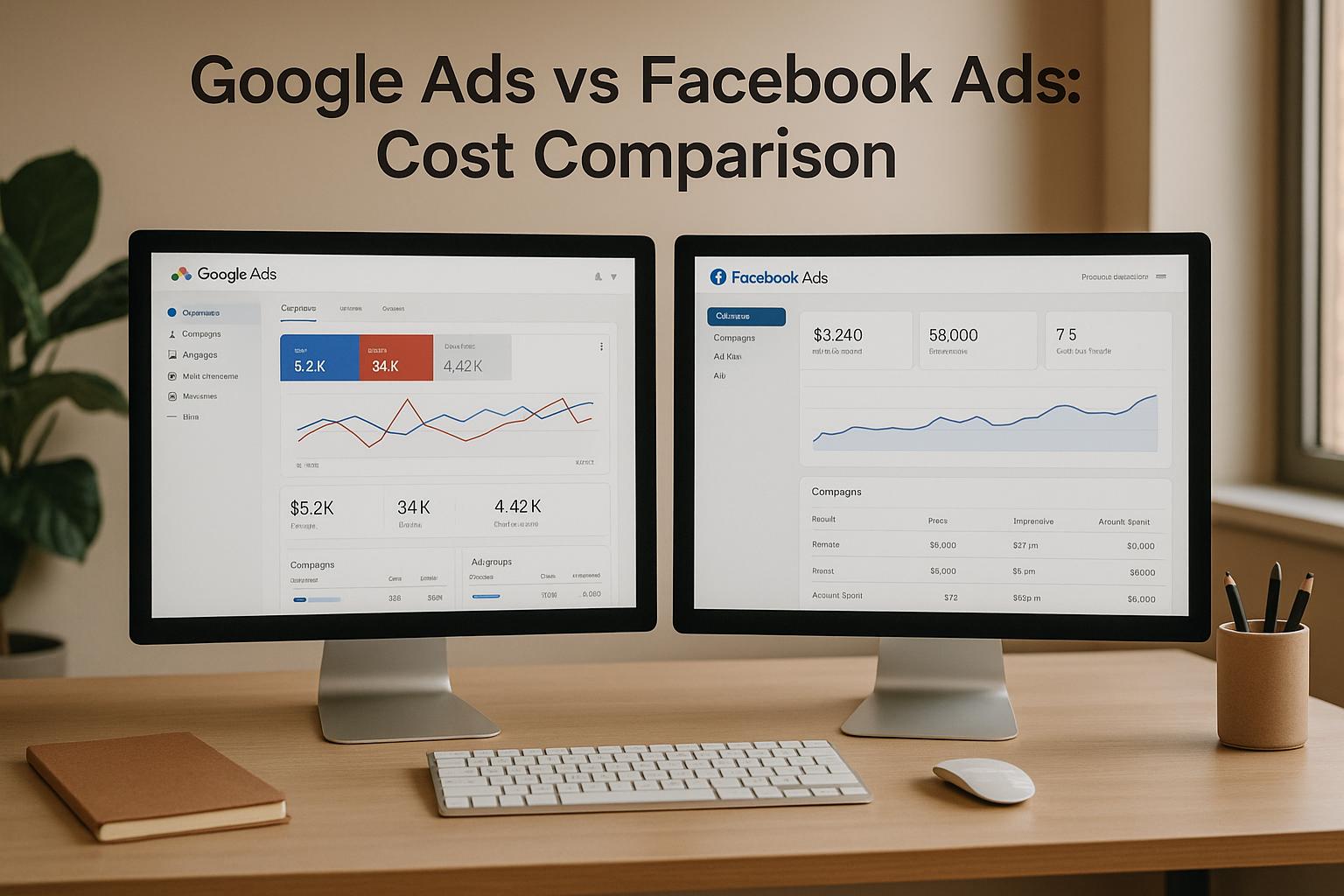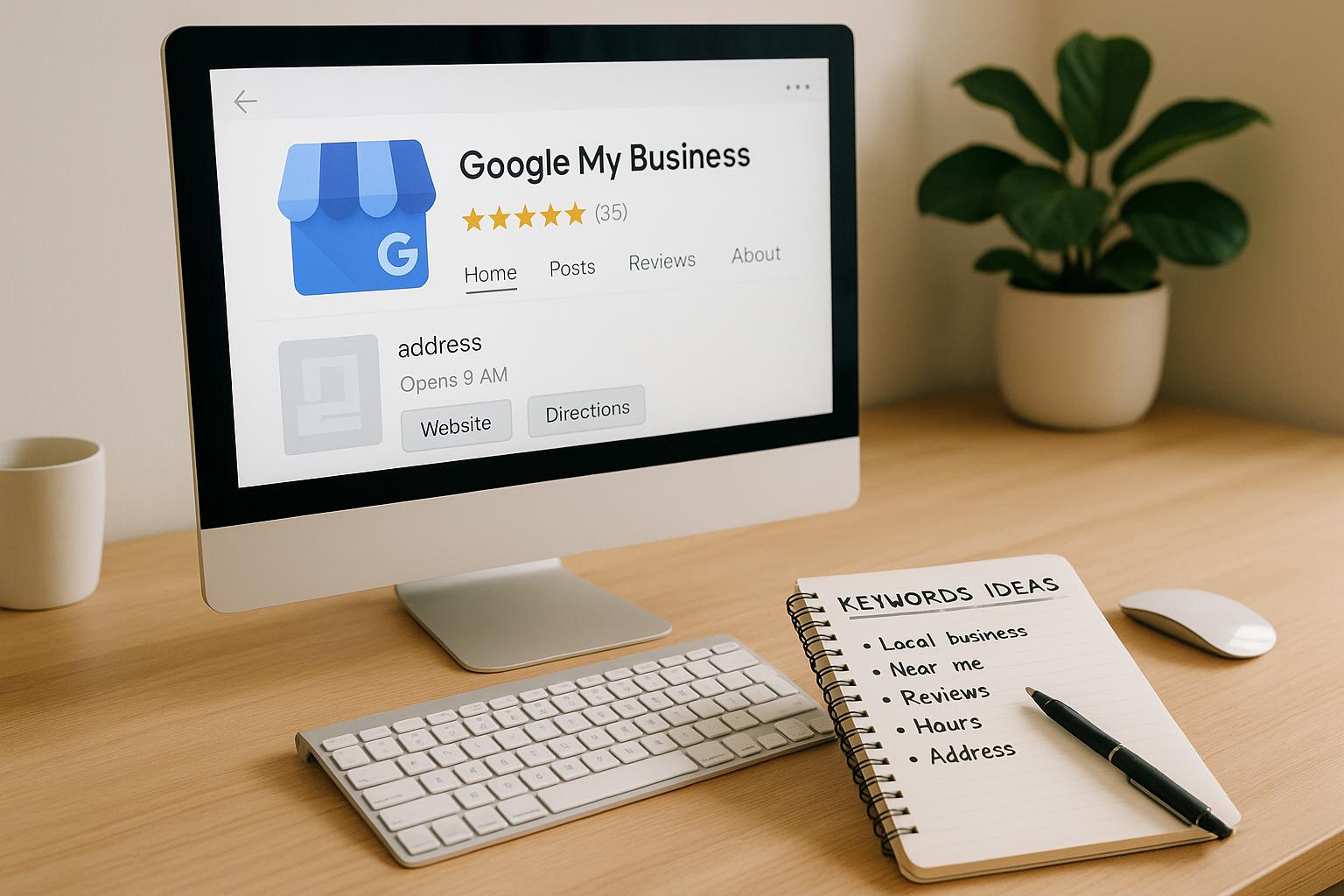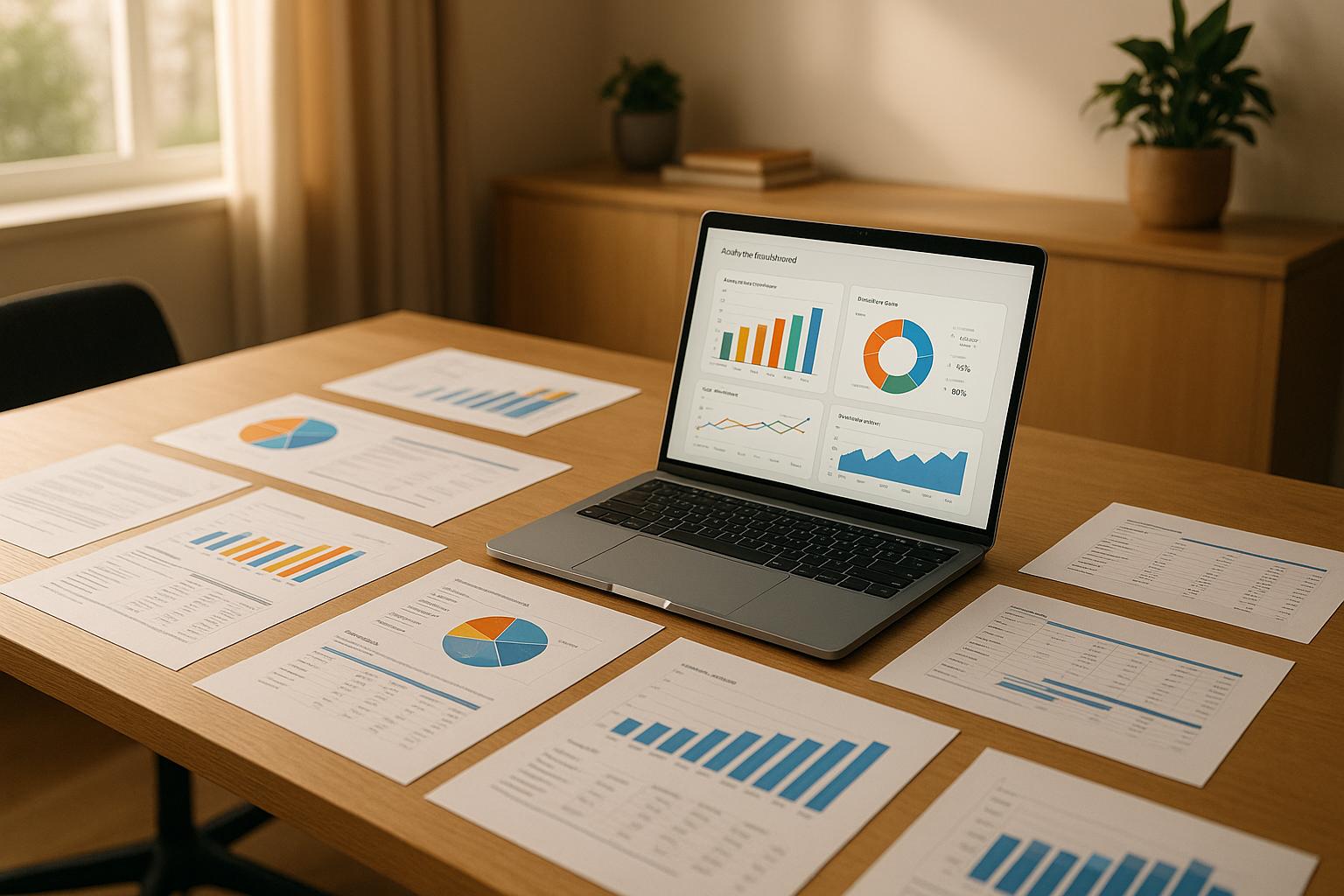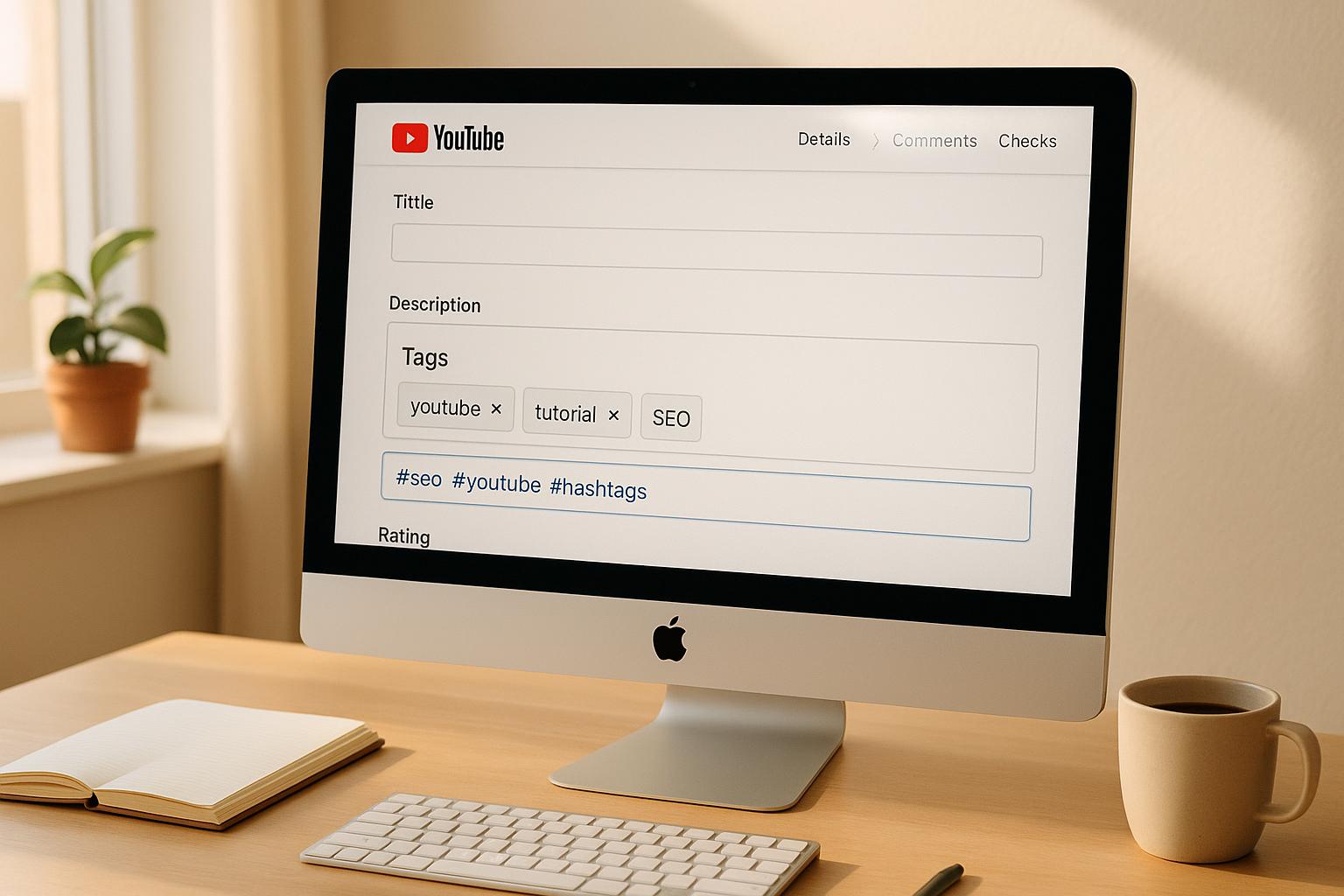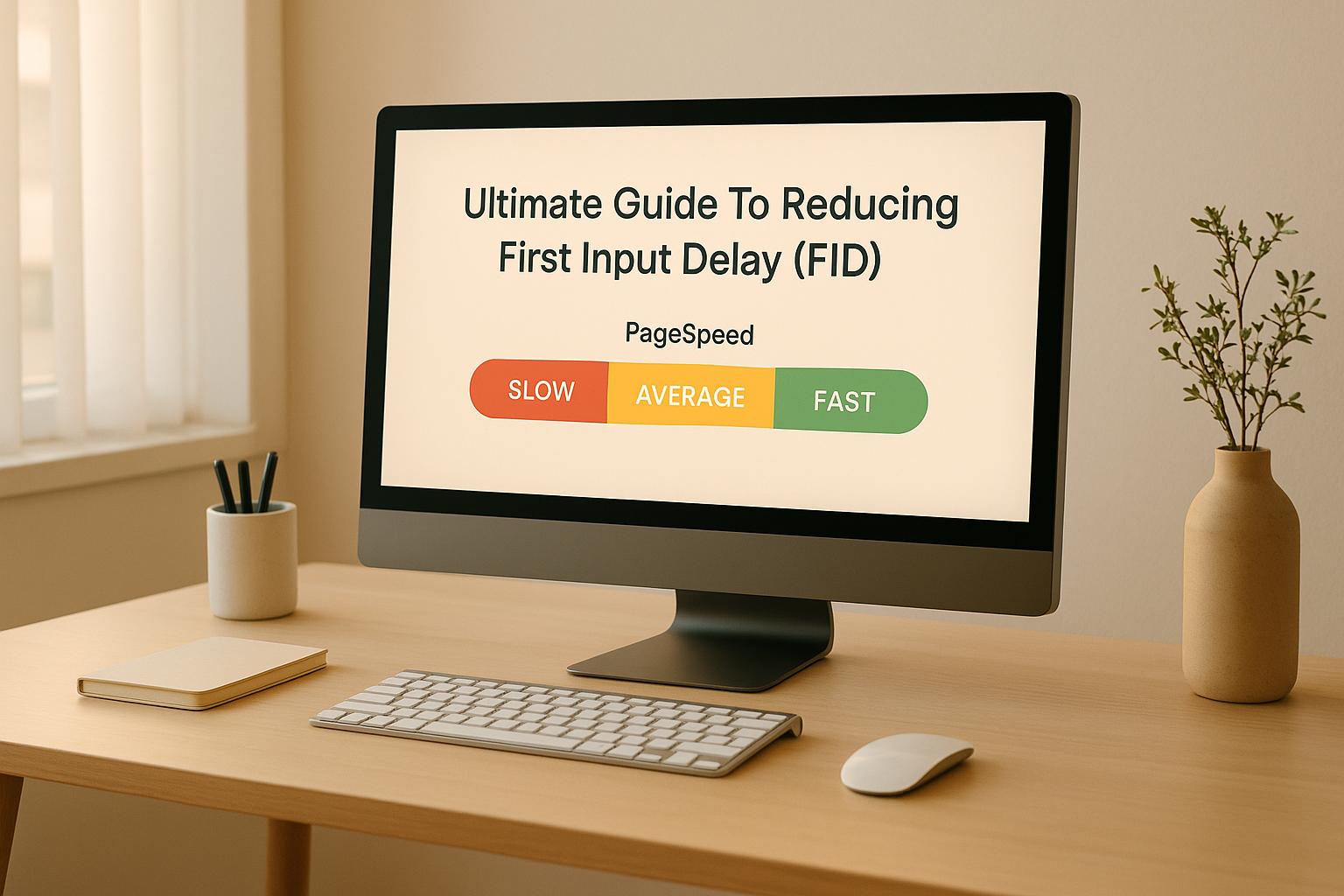Google Ads vs Facebook Ads: Cost Comparison
September 22, 2025Choosing between Google Ads and Facebook Ads depends on your goals, audience, and budget. Google Ads targets users actively searching for products or services, while Facebook Ads engages users based on interests and behaviors. Here's a quick breakdown:
- Google Ads: Higher cost-per-click (CPC) but ideal for high-intent searches like "urgent care near me." Best for industries like healthcare, education, and e-commerce aiming for quick conversions.
- Facebook Ads: Lower CPC, great for brand awareness and engaging users earlier in their decision journey. Suited for visually-driven industries like e-commerce or wellness services.
Key Cost Metrics:
- Google Ads: CPC varies by industry and competition. Uses a second-price auction model influenced by ad quality.
- Facebook Ads: Average CPC in the U.S. is $0.70 (as of June 2025). CPM and audience targeting also affect costs.
Budget Considerations:
- Google Ads: Requires higher budgets for competitive industries but offers scalable results.
- Facebook Ads: Lower entry costs, flexible budgeting options, and better for testing new markets.
Quick Comparison:
| Feature | Google Ads | Facebook Ads |
|---|---|---|
| Focus | Search intent | Interests & behaviors |
| CPC | Higher | Lower ($0.70 avg in 2025) |
| Best For | High-intent industries | Brand awareness campaigns |
| Budget Flexibility | Moderate | High |
Both platforms can complement each other. For example, e-commerce brands often use Facebook for discovery and Google for conversions. The choice depends on your strategy and audience behavior.
Google Ads Pricing Breakdown
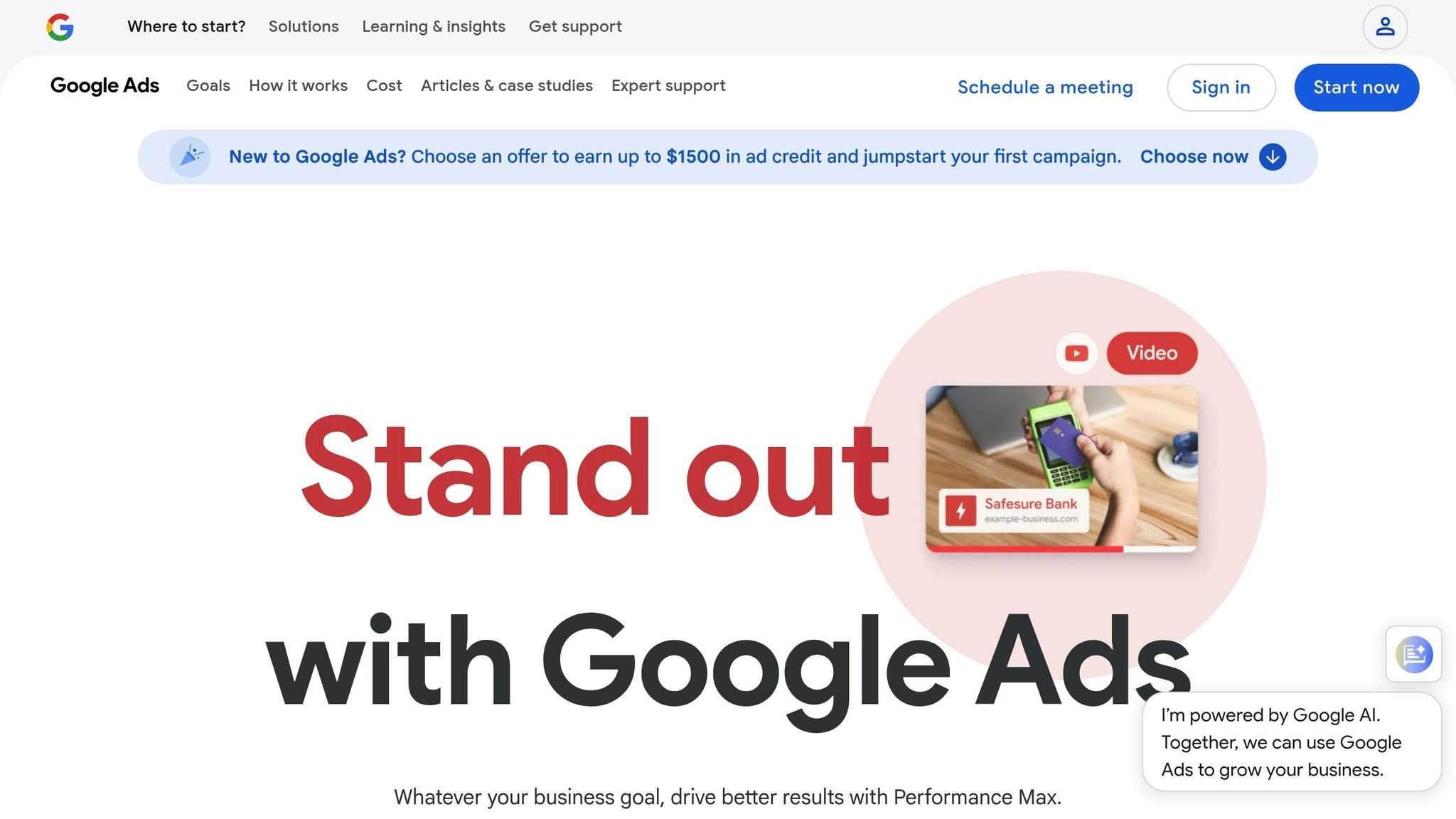
How Google Ads Pricing Works
Google Ads uses a real-time auction system that kicks into action every time someone performs a search. This auction determines whether your ad will appear, where it will be placed, and how much you'll pay if it gets clicked. The process revolves heavily around a key metric called Ad Rank.
Ad Rank is a combination of several factors: your bid amount, your ad's Quality Score, Ad Rank thresholds, the searcher's specific context, and the influence of ad extensions. Here's where it gets interesting - Google operates on a second-price auction model. This means your cost-per-click (CPC) is calculated by dividing the next highest Ad Rank by your Quality Score. So, if your ad is well-optimized and scores high in quality, you can achieve better placement at a lower cost, even if your bid isn't the highest.
Facebook Ads Pricing Breakdown
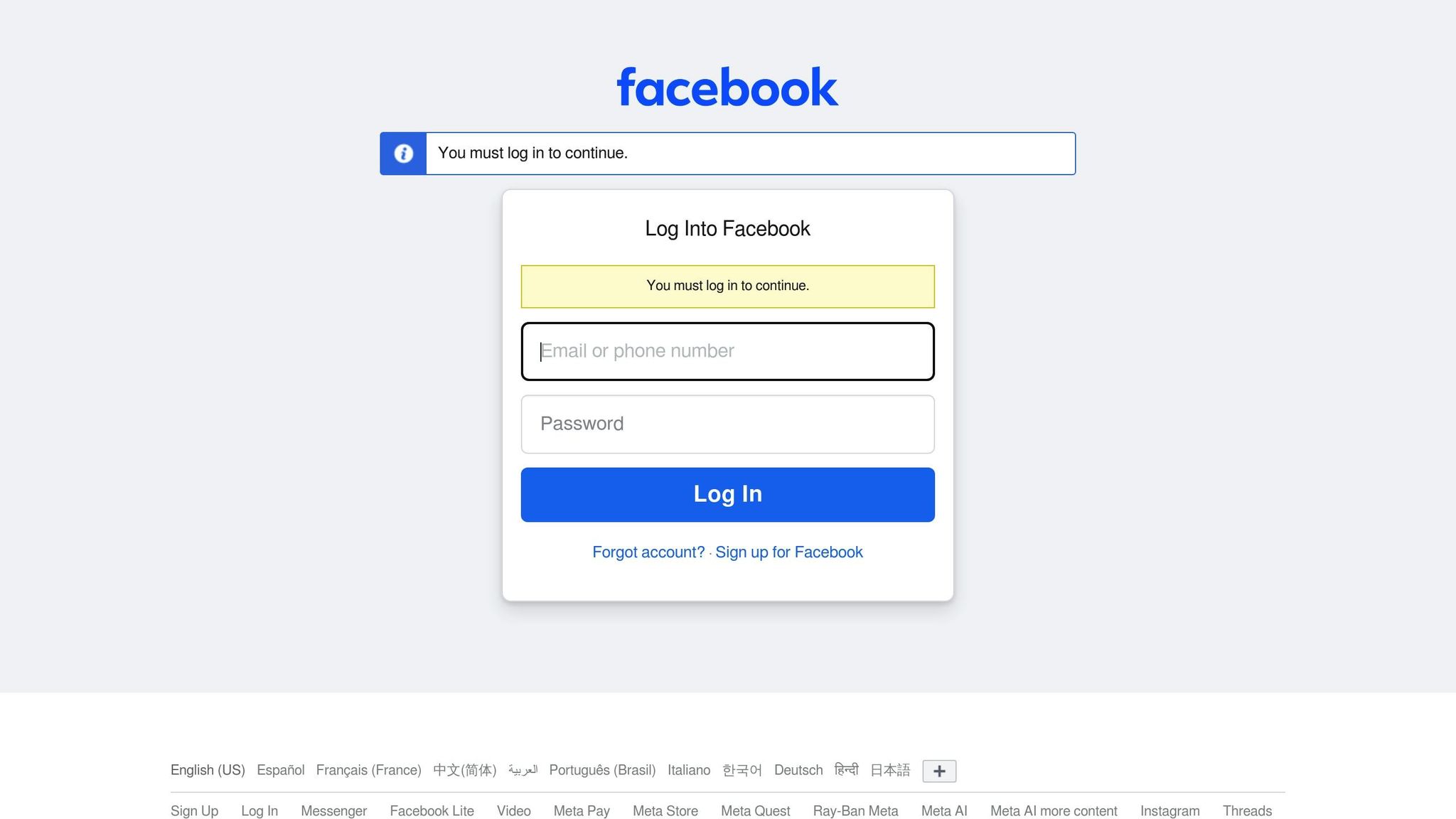
How Facebook Ads Pricing Works
Facebook operates on an auction-based system where advertisers bid to reach their target audience. But it’s not just about who bids the most. Facebook also considers ad quality and audience relevance alongside the bid amount to determine which ads get displayed.
When setting up a campaign, you’ll select your objective and budget. Facebook then uses a quality score (ranging from 1 to 10) to optimize how your ads are delivered. This score is based on factors like user reactions, engagement, and conversions. One interesting twist: Facebook can exceed your daily budget by as much as 75% during high-opportunity moments. However, your weekly spending will stay within seven times your daily budget. This dynamic approach directly impacts the cost metrics discussed below.
Average CPC and CPM Rates in the U.S.
As of June 2025, Facebook's average cost-per-click (CPC) held steady at $0.70, maintaining the same rate as in 2024. However, actual costs can vary widely depending on your campaign goals. For example, campaigns focused on conversions - like "Catalog Sales" - often come with higher CPCs compared to awareness campaigns. Similarly, industries with higher customer lifetime values, such as healthcare or financial services, typically face more competition and, consequently, higher CPC rates.
Ad frequency also impacts costs. If users see the same ad too often, they can experience ad fatigue, which leads to increased costs and reduced effectiveness. Additionally, Facebook's algorithm takes time to fine-tune campaign performance. After any significant campaign change, the system needs around 50 optimization events within a week to exit the "learning phase." During this phase, costs may fluctuate as the algorithm adjusts its targeting based on audience behavior.
Facebook Ads Budget Requirements
Facebook provides flexible budgeting options, allowing you to choose between daily or lifetime budgets. While the platform may occasionally spend more than your daily budget during peak times, it ensures that your total spend stays within your budget limits over time. This flexibility helps advertisers capitalize on high-performing opportunities without exceeding their overall financial plan.
Google Ads vs. Facebook Ads (Which One Is Right for You?)
sbb-itb-cef5bf6
Industry-by-Industry Cost Comparison
Advertising costs can vary significantly depending on the industry, especially when comparing Google Ads and Facebook Ads. Knowing these differences is key to setting realistic budgets and identifying which platform delivers the best results for your business.
E-Commerce Costs
For e-commerce businesses, Facebook Ads often shine when it comes to product discovery campaigns. The platform's visual nature and precise targeting options make it ideal for showcasing products and reaching potential customers. On the other hand, Google Ads are particularly effective at capturing high-intent shoppers - those actively searching for specific items. Many e-commerce brands combine the two: using Facebook Ads to build brand awareness and introduce new products, while relying on Google Ads (like Google Shopping campaigns) to convert ready-to-buy customers. The balance between these platforms often depends on the specific niche within e-commerce.
Medical Services Costs
The healthcare industry typically faces higher advertising costs, largely due to the higher lifetime value of customers and strict regulations. Google Ads are often the go-to for urgent care and specialist searches, where people are actively looking for immediate solutions. In contrast, Facebook Ads tend to work well for wellness services, cosmetic treatments, and preventive care. The platform’s visual and engaging format helps build trust and connect with audiences, making it a strong choice for less time-sensitive healthcare offerings.
Education Costs
For educational institutions and online learning platforms, advertising costs tend to fall in the middle range. Decision-making in this sector is often slower, which gives both platforms distinct advantages. Facebook Ads excel at targeting specific demographics and interests, helping advertisers reach prospective students effectively. Meanwhile, Google Ads perform better at capturing high-intent leads - those actively searching for programs or courses. Many educational advertisers use a combination of both: Facebook for raising awareness and Google Ads to drive enrollment when prospects are ready to commit.
Budget Planning and ROI Tips
When planning your ad budget, it’s essential to align your strategy with the unique strengths of each platform. Google Ads focuses on clicks and intent-driven searches, while Facebook Ads thrives on engagement and audience interaction.
How to Calculate Ad Budgets
Start by setting clear monthly goals for leads or sales. For Google Ads, calculate your budget by multiplying your target number of clicks by the estimated cost-per-click (CPC). Don’t forget to include a small buffer to account for unexpected fluctuations.
For Facebook Ads, base your budget on anticipated reach and engagement levels. Begin with a conservative amount, then adjust as you gather performance data. Factor in your customer lifetime value (CLV) to ensure your acquisition costs remain manageable and profitable.
Once your budget is set, it’s time to consider what factors will influence your return on investment (ROI).
What Affects ROI
ROI depends heavily on your conversion rates, which are influenced by several key elements:
- Ad relevance and targeting: The more precise your targeting, the better your chances of reaching the right audience.
- Landing page quality: A well-designed landing page that aligns with your ad message can significantly improve conversions.
- Platform dynamics: Google Ads is ideal for capturing users with immediate intent, while Facebook Ads often requires more nurturing to convert leads.
- Campaign timing and creative updates: Running your ads at the right time and refreshing your creatives regularly can also make a big difference.
Campaign Optimization with SEO Werkz
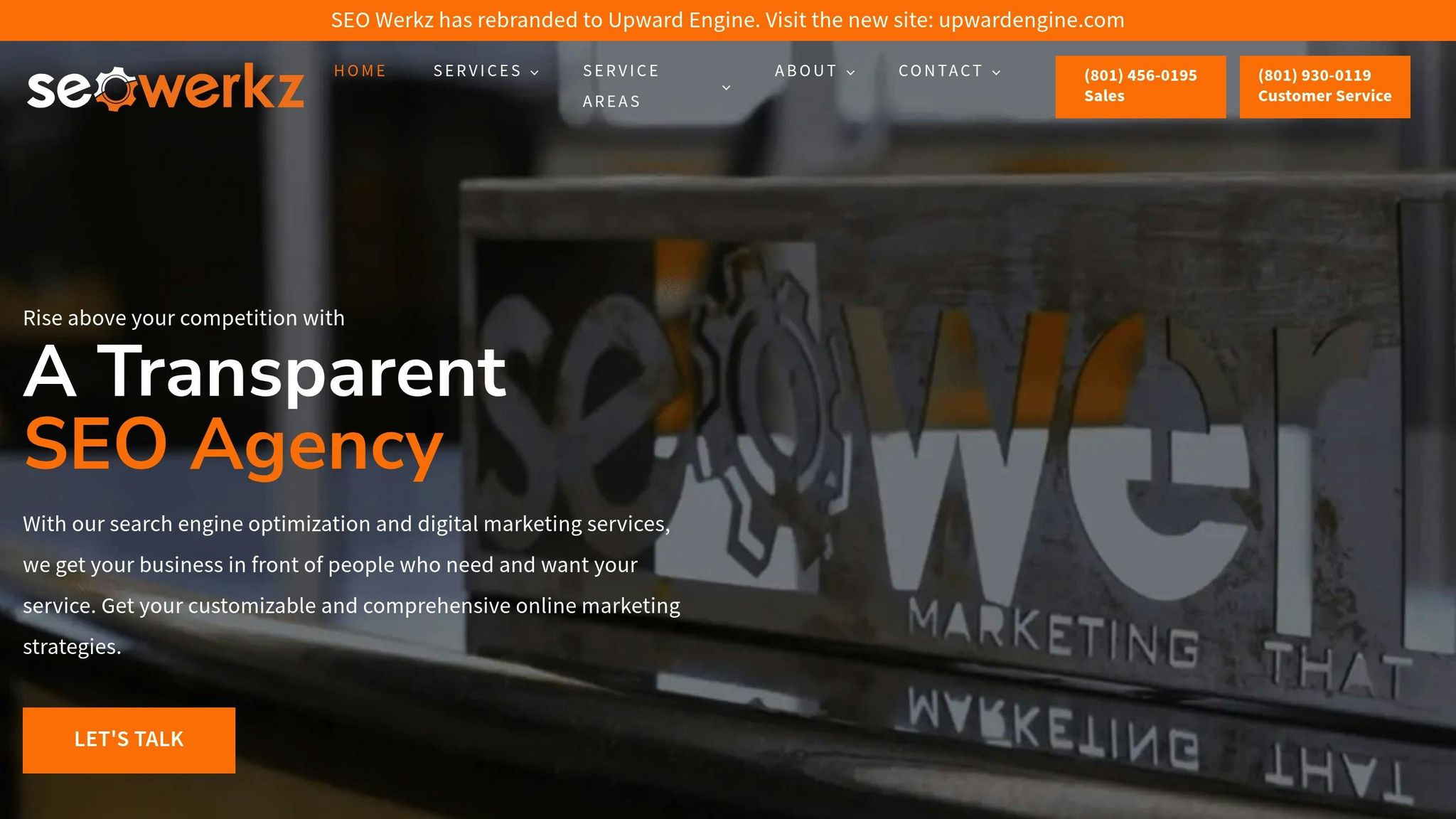
To get the most out of your ad spend, continuous optimization is non-negotiable. This means regularly testing ad creatives, experimenting with audience segments, and fine-tuning bids. Companies like SEO Werkz specialize in refining these strategies over time, helping you achieve better ROI through data-driven adjustments and ongoing improvements.
Which Platform is Right for Your Business
When it comes to deciding between Google Ads and Facebook Ads, the choice boils down to your business goals, how your target audience behaves, and what your budget allows. Both platforms serve distinct purposes in the marketing funnel, and understanding these differences can help you make the most of your advertising spend.
Google Ads is a powerhouse for reaching users who are already searching for what you offer. It's especially effective for industries like e-commerce, medical services, and education, where high-intent traffic often leads to quicker conversions. For example, someone searching for "urgent care near me" or "online coding courses" is likely ready to take action, making the higher cost-per-click (CPC) worthwhile.
On the other hand, Facebook Ads shines when you’re looking to build awareness and engage potential customers earlier in their decision-making process. This platform is ideal for businesses with longer sales cycles or products that need more explanation. It’s also a great choice for expanding your reach with creative and highly targeted campaigns. For instance, an e-commerce brand might use Facebook to showcase new products to users who didn’t even know they needed them.
The industry you’re in can also influence your choice. E-commerce brands often combine both platforms - using Facebook Ads to introduce products and Google Ads to capture ready-to-buy customers. Medical services might lean more heavily on Google Ads due to the urgency of health-related searches, while educational institutions can use Facebook to connect with younger audiences and nurture long-term relationships.
Budget is another key factor. If you’re working with a tight budget, Facebook Ads offers flexibility and lower entry costs. Larger budgets, however, can take advantage of Google Ads' ability to drive scalable and high-volume results.
Ultimately, successful advertisers start by focusing on the platform that best aligns with their immediate needs. As campaigns show results, they can expand efforts to maximize reach and efficiency, ensuring every dollar spent delivers value.
FAQs
Which is better for my business goals and industry: Google Ads or Facebook Ads?
Choosing between Google Ads and Facebook Ads largely depends on what you’re aiming to achieve and the type of industry you’re in. If your primary goal is to reach people actively searching for specific products or services, Google Ads is a strong contender. This platform works especially well for businesses in sectors like e-commerce or professional services, where potential customers are often ready to make a purchase or take immediate action.
On the flip side, Facebook Ads shine when it comes to creating brand awareness and sparking audience engagement through visually appealing and emotionally driven content. This makes them a great choice for industries like education, healthcare, or lifestyle brands - areas where building trust and long-term relationships is key.
In short, think about your goals: if you’re looking for direct sales or conversions, Google Ads is likely to deliver better results. But if your focus is on expanding your audience and nurturing connections over time, Facebook Ads might be the way to go.
How can I set an effective budget for Google Ads and Facebook Ads to maximize ROI?
To create an effective budget for Google Ads and Facebook Ads, start by defining your advertising goals - whether that's driving more traffic to your website, generating leads, or increasing sales. These goals will guide how you allocate your funds and measure success.
Next, think about your target audience and the industry you operate in. Costs like cost-per-click (CPC) and cost-per-thousand impressions (CPM) can vary widely depending on your audience's demographics and the competitiveness of your market.
It’s a good idea to begin with a test budget. Use this phase to gather performance data and analyze metrics like CPC, CPM, and conversion rates. This data will help you make informed adjustments. Don’t forget to factor in seasonal trends, your campaign's specific objectives, and the bidding strategies unique to each platform.
By keeping a close eye on your campaign performance and making ongoing optimizations, you can allocate your budget more effectively and improve your return on investment.
What’s the difference between Google Ads and Facebook Ads when it comes to targeting customers at different stages of their buying journey?
Google Ads is all about connecting with users who have high purchase intent - those actively searching for a specific product or service. This makes it an excellent choice for reaching potential customers who are ready to make a decision and are further along in the sales funnel.
On the other hand, Facebook Ads shine when it comes to building awareness and sparking interest earlier in the buyer's journey. By tapping into detailed data on demographics, interests, and behaviors, Facebook Ads allow you to engage with audiences who might not yet be searching for your product but are likely to interact with your brand.
Put simply, Google Ads helps you capture existing demand, while Facebook Ads focuses on creating demand and nurturing prospects.
